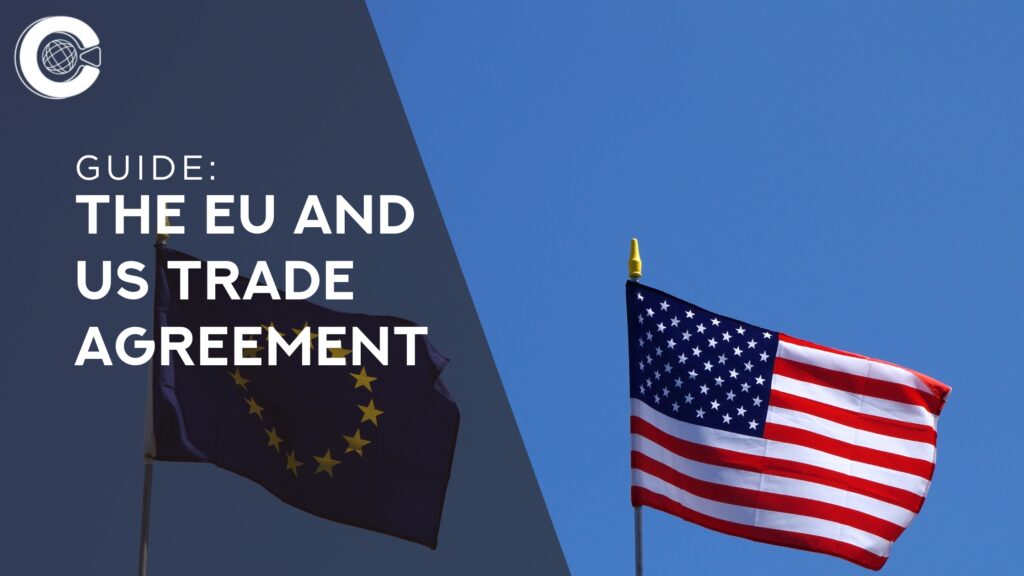The EU and US Trade Agreement
The European Union and the United States have reached a new political agreement on tariffs and market access. Announced on 27 July 2025 by EU Commission President Ursula von der Leyen and US President Donald J. Trump, the EU and US trade agreement aims to reset transatlantic trade relations and resolve long-standing disputes across several key sectors.
With more than €1.7 trillion in annual trade between the EU and US, the deal is significant for companies involved in export and import on both sides of the Atlantic. Below, we outline the most relevant changes introduced under the EU and US Trade Agreement and what they mean in practice.
The EU and US Trade Agreement
Tariff Ceiling under the EU and US Trade Agreement
A central element of the agreement is the introduction of a 15 percent all-inclusive tariff ceiling for nearly all goods exported from the EU to the United States. This replaces the patchwork of tariffs and surcharges previously applied under Section 232.
Starting 1 August 2025, this new ceiling applies across sectors including automotive, consumer electronics, textiles, and machinery. For example, automotive goods that were previously subject to tariffs of up to 27.5 percent will now benefit from this fixed cap. The agreement ensures that the US cannot impose tariffs above 15 percent on EU products unless the existing MFN rate is already higher, which is rare. This provides predictability for EU exporters and reduces the risk of sudden cost increases due to trade policy shifts.

Strategic Relief for Key Sectors in the EU and US Trade Agreement
The agreement also restores pre-2021 duty levels for several strategic goods. This includes aircraft parts, chemicals, pharmaceuticals, and raw materials such as cobalt, lithium, and rare earth metals essential to manufacturing across Europe. These changes reduce costs for companies shipping to the US and help reinforce resilient supply chains.
Exporters in sectors such as aerospace, automotive components, medical devices, and biotechnology can now operate with fewer trade barriers, improving their ability to compete in the US market.
Metal Tariffs and Quotas in the EU and US Trade Agreement
The metals sector has seen some of the most contentious trade restrictions in recent years. Under the EU and US Trade Agreement, the two regions will now coordinate quotas for steel, aluminium, and copper. These quotas are based on historical trade volumes and replace the previous 50 percent tariffs imposed on many EU-origin goods.
By managing access through quotas, the two sides aim to prevent overcapacity and market dumping, especially from non-market economies. This offers more stability in accessing the US market and helps ensure compliance with fair-trade standards.
Elimination of EU Industrial Tariffs on US Goods
The agreement eliminates the remaining EU tariffs on industrial imports from the US. While most duties in this area were already low, their removal simplifies customs procedures and reduces friction for manufacturers, wholesalers, and B2B distributors.
Importers of US-made machinery, tools, and components will benefit from a simplified process and marginal cost savings.
Controlled Market Access for US Agri-Food Products
The EU will now allow limited and structured access to selected US agricultural and fishery products, including:
- Alaska pollock and Pacific salmon
- Soya oil and other vegetable oils
- Corn, wheat, and barley
- Tomato concentrates and sauces
Access will be managed via quotas and defined timelines, giving EU-based manufacturers of canned goods, sauces, animal feed, and cooking oils access to more affordable raw materials while preserving protections for sensitive sectors like poultry and beef, which remain excluded from the agreement.
Reducing Non-Tariff Barriers
An important element of the EU and US Trade Agreement is the reduction of non-tariff barriers, which cause administrative delays and increase costs. The deal focuses on better regulatory alignment in key areas.
- Automotive standards: Improved compatibility between EU and US standards will reduce the time needed for certification, especially for parts and electric vehicles.
- Sanitary and phytosanitary rules: Mutual recognition of inspections and processes will ease the import of food, beverages, and agricultural goods.
- Conformity assessments: The two regions will now accept test results and product inspections carried out by each other’s accredited bodies. This supports smoother movement of machinery, electronics, and other regulated products.
These changes are especially helpful for SMEs, who often lack the capacity to manage duplicate testing or long delays.
EU Commitments on Energy and Digital Procurement
The EU has committed to purchasing more US-origin energy and technology products over the next three years, including:
- €700 billion in energy supplies, including liquefied natural gas (LNG), enriched uranium, and smart grid equipment
- €40 billion in AI chips and digital infrastructure components, such as semiconductors, 5G modules, and cloud server hardware
These purchases support EU priorities on energy security, supply diversification, and digital transformation, while reinforcing economic ties with the United States.
Implementation and Investment Outlook
While the agreement is currently political and not yet legally binding, implementation is expected in the coming months. The scale and scope of the deal are already influencing business strategy on both sides of the Atlantic.
EU companies are expected to invest over €550 billion in the United States by 2029, building on existing operations and seeking new commercial opportunities under the improved trade environment. Many businesses are planning expansions in sectors like renewable energy, logistics hubs, and data centres, taking advantage of more predictable trade conditions and reduced entry barriers. The agreement is seen as a major confidence booster in EU-US commercial relations.
Key Actions for Businesses Under the EU and US Trade Agreement
For companies involved in trade between the EU and the US, now is the time to assess the operational impact of the agreement. Recommended next steps include:
- Review customs classifications and duty calculations
- Track quota limits for metals, agricultural, and fishery products
- Monitor changes in product standards, certifications, and SPS requirements
- Engage with your customs broker or supply chain team to ensure compliance
- Explore sourcing and investment opportunities under the revised conditions
At Customs Complete, we help companies adapt to evolving trade agreements with clear, actionable advice on customs clearance, regulatory compliance, and supply chain planning.
If your business trades with the United States, now is the right moment to prepare for the changes ahead.
